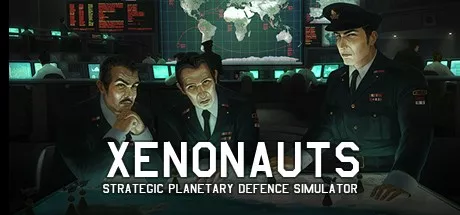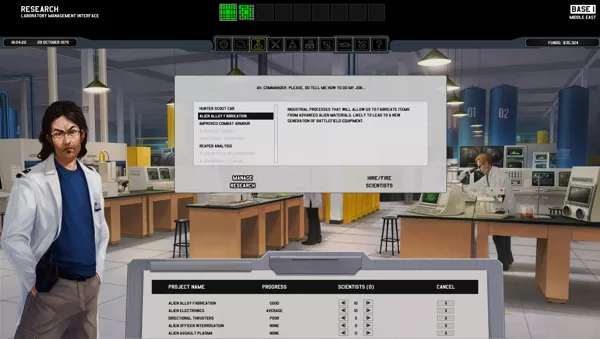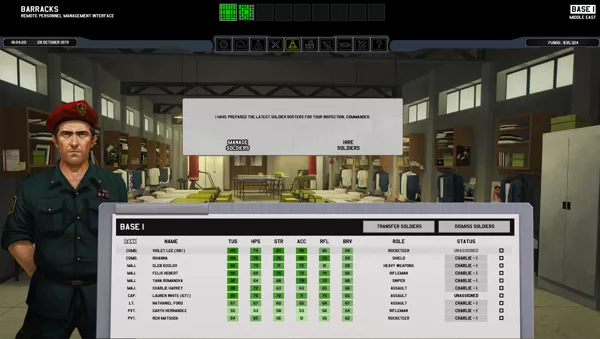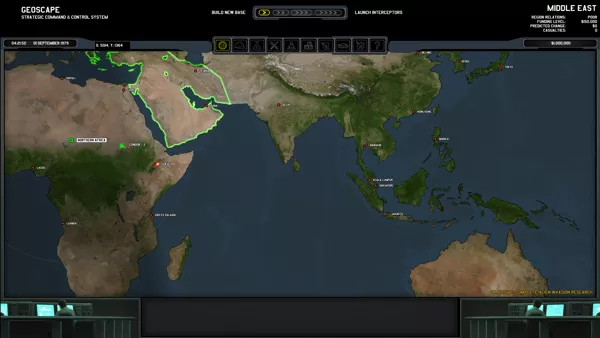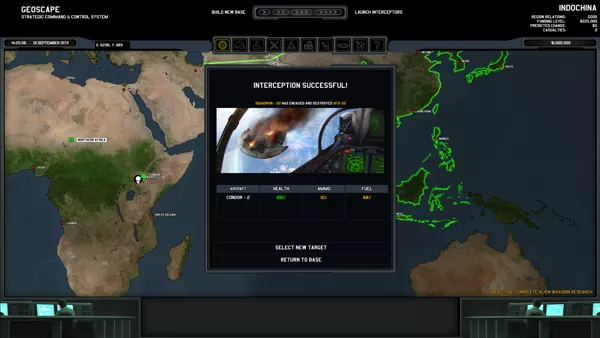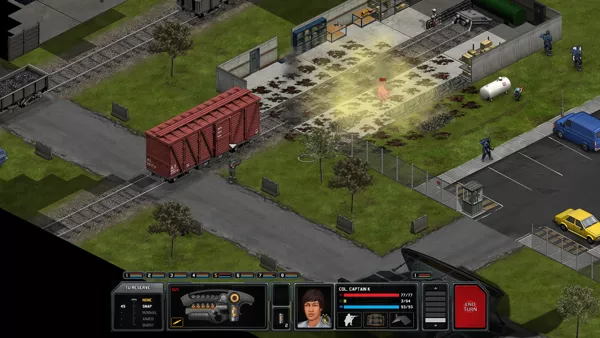Xenonauts
Description
Xenonauts is a single-player turn-based strategy game, in which the player takes command of the eponymous elite military organization, the world's last line of defense against a potential extraterrestrial invasion. The story starts in year 1958, in what was known as the Iceland Incident, a huge spaceship was shot down over Iceland by eight missiles with nuclear warhead. After a six-hour battle with the ship's crew members at the crash site, the mobilized elements of the 95th Airborne, 202nd Infantry and Soviet Fourth Army were all wiped out in their entirety when the aliens purposefully detonated the ship's power core. Shortly after, the Xenonauts was founded to research and counter the potential alien threat. However, it wasn't until 1979 when the whole world are aware of the existence of the aliens and the emponymous military organization. Their offer was simple - fund them, and they will fight what no one else could.
The game contains two main interfaces: Geoscape and Battlescape
GEOSCAPE Building and expanding.: The player would first choose the location for the first base of operation. From there, they will have to build more facilities like radars to expand the UFO detection radius, hangars to hold more aircrafts and dropships, workshops to build new equipment, laboratories to research alien tech. Each of the facility have their own cost and upkeep, so it is extremely important to carefully consider the cost-versus-practicality.
Managing personnel. : The player is required to hire soldiers, scientists and engineers to fight, research and build things, respectively. Like with facilities, there are hiring costs and monthly salaries. When multiple research options become available, the player must choose what to develop: new armor, new weapons or study more about the aliens? There is also a necessity to equip soldiers with weapon and equipment, which the game facilitates by introducing "roles" as quick equipment setups.
Air battle. : When UFOs fly within range of the base's radar, interceptors can be sent to shoot them down (the air battles can be automatically resolved, or played out in a real time mini game). The world are divided into 10 geo-political regions, as UFOs are shot down over each region, the player's reputation and funding from said region is improved. Neglecting to protect a region for too long, and they will eventually surrender to the aliens. The funding received at the beginning of each month is vital for building and expanding new bases and hire more personnel to counter the growing alien threat.
BATTLESCAPE
Battlescape takes place when the player investigate crash sites, attack landed ships, or assault alien bases. Depending on where the location is on the world map, an appropriate map is chosen (which can be desert, farm or urban area). The player can bring as much Xenonauts as the dropship is able to carry (which is 8 at the beginning of the game). The battles takes place in turn-base isometric view, with each side take turn moving their units around. Each Xenonaut have a certain amount of Time Units (equivalent of action points) which can be spent on moving, firing, changing equipment, etc, or reserved to fire at aliens entering view during enemies' turn (reaction fire). Each battle requires the player to carefully consider using covers, limited field of view, reaction fire to successfully complete mission with their troops intact. Successful completing missions will grant soldiers with additional stat points, which improve their effectiveness in later battles. "Dead" soldiers have a small chance of surviving the battle and recovering; otherwise they will have to be replaced. Intact alien weapon and equipments can be researched, sold for money; aliens captured alive can be interrogated, and the dead ones dissected for research.
Groups +
Screenshots
Promos
Videos
Add Trailer or Gameplay Video +1 point
See any errors or missing info for this game?
You can submit a correction, contribute trivia, add to a game group, add a related site or alternate title.
Credits (Windows version)
63 People (41 developers, 22 thanks) · View all
| Project Lead | |
| Design Team | |
| Programming Team | |
| Art Team | |
| Additional Art | |
| [ full credits ] | |
Reviews
Critics
Average score: 83% (based on 7 ratings)
Players
Average score: 3.9 out of 5 (based on 8 ratings with 1 reviews)
Repetative, but true to its roots
The Good
Xenonauts was created to be the most faithful remastering of the original XCOM, and very likely it remains so to this day, even though an official remake has since been released. Remarkably it manages that despite Xenonauts several key changes to the original game.
The story of the game has been completely revamped - it is no longer set in the near future, but in the past, during the height of the Cold War. This sets a far more grim and gritty atmosphere throughout the game, whereas the original was somewhat more cartoonish. The music, images and aircraft designs (most of which were inspired by real-life experimental aircrafts of the period) all reflect this setting.
Another new addition is air dog-fights where you can control up to three planes and have to take out up to three enemy planes. You can issue orders to launch rockets, make evasive action and carefully maneuver your planes to strike the least protected parts of the alien vessels while staying clear of their firing arcs. The amount of fuel and ammo your aircrafts have at the moment of engagement are crucial for an effective battle strategy. Best of all this feature is optional, as you can opt to auto-resolve every air battle.
Perhaps the best change is the streamlining of the economy. You no longer have to produce/buy every single ammo box and air-to-air missile. All ammunition is available in infinite amounts and aircraft and land vehicle weapons and ammo are available instantly the moment they are researched. It doesn't make all that much sense in-game, but it's a huge relief from the mundane task of managing every single bullet and rocket. The downside is that alien weapons cannot be used and they are auto-sold after every mission. The alloys and energy crystals that you collect and store (storage space is also infinite as long as you have at least one storage facility) can be sold for mere pennies, and their use is mainly for building new weapons, armor, vehicles and aircraft.
The AI is fairly decent. Aliens are initially positioned randomly on any given map and for the most part they will try to act depending on their racial profile; some will crouch behind corners and door, depending heavily on reaction fire and ambushing you if you come near them unprepared (the Reapers, which can insta-kill anyone and turn them into a bloated zombie that produces another Reaper when killed, are particularly deadly when employing this strategy).
All in all the game is very enjoyable for the first half or so, until the problems become more evident...
The Bad
The first of those problems is the very low replayability. There are about ten map, each with roughly two possible layouts (and each enemy ship class has between one and two layouts), making the maps very boring once you've seen them all (which will be sooner rather than later). Since there is some randomness (the position of the downed alien vessel, the positions of the crew, some minor landmarks) each map is still played differently, but the moment I've gotten to the point where I'm destroying alien carriers the could be practically automated for my part.
It doesn't help that the crew composition is always the same for each intercepted ship class: Scouts will always have either six Caesans (their version of Sectoids) or six Sebillians (the Snakemen analog), while bigger ships will always have either mostly Caesans with a few Wraiths (teleporting elite troops) or Sebillian with a few Reapers or Androns (heavily armored robotic units that can't take cover) with a few Light Drones (in earlier missions) or with Harridans (flying sniper units) in later missions. The mix is always the same and once you've spotted your first enemy on the map you will know exactly how many of each creature you will face.
Terror missions are an exclusion to this rule since they can have three alien types, but the later you progress in the game the less you'll see of them because your air defense would be strong enough to defeat most attackers, unless they spawn very badly.
Speaking of which: Another problem with replayability is that you always must build you first base somewhere on the Mediterranean because you must cover as many countries as you can and that location maximizes your coverage. The alien vessels spawn in waves instead of one by one - several enemy groups will appear in each wave randomly on the map. The further you've progressed the more powerful the groups will be (initially each "group" is just one light scout, but by the end you'll see groups of one heavy cruiser and two fighters and the like). The problem is that the spawn location is entirely random. If you're lucky they'll be nicely dispersed around the globe. But what if you're not lucky? Oh boy. The groups can all appear within the airspace of a single funding nation, which will overwhelm even a main base, leaving your funding from that nation severely reduced. If that happens a couple of times in a row you will lose that nation entirely and forever. The is no way to prevent it (other than unmanageable redundancy in the form of too many planes at every single base) and you are left to whims of the RNG gods.
This randomness infects even the tactical battles themselves. No, I'm not talking about the to-hit chance when shooting at a distance or enemies taking cover - that's what gives the game its appeal. No, I'm talking about psychic powers. Caesan elites and Praetors (this game's Ethereals) have access to the terrify (causes your soldier to run in panic for one turn), hallucinate (causes a soldier to fire indiscriminately at the nearest unit) and mind control (takes over one soldier for one turn). They can use these abilities without line of sight (i.e. the enemy psycher is safely stationed in the innermost part of the ship and constantly attacks your troops while they're still clearing the streets) and seemingly at random - I've often seen soldiers with 99+ bravery (the one stat that is supposed to protect you from such attacks) get taken over. Mind you, having a soldier mind controlled isn't that bad because you'll have a turn to move your soldier away from him or her (the mind controlled one acts during the aliens' turn), but hallucination takes effect immediately and causes the affected to quickly kill their nearest team-mate with focused fire at the beginning of your turn.
Other than that there is the problem of weapon variety. The game has several weapons (hand gun, shotgun, assault rifle, sniper rifle and machine gun) not including the rocket launcher (which stays the same for the entire game) that could be upgraded up to three times - to lasers, then to plasma and finally to MAG (particle accelerated weaponry). Your vehicles and aircraft follow the same path.
Each upgrade only increases the damage of the weapon without changing any other stat about it (though the first upgrade usually reduces ammo size) meaning that you never have to think about your weapon composition more than once in the entire game. A party that served you well in the beginning will continue to serve you equally well regardless whether they use beam or particle weaponry.
It would have been nice if the creators made at least two research trees, say a beam and particle upgrade paths, each with their unique characteristics, as well as different damage, and that might have been the initial idea since the game still mentions incorrectly that some enemies are more susceptible to laser fire (in reality those enemies are more susceptible to sniper weaponry), but it did not made it to the finished product.
For me that was a big drawback because one of the things that I like most in other games (like UFO: Alien Invasion that do have different profiles) is how to change the party to incorporate the each new technology which weapon profile might be different from what I'm used to.
In essence the "technological breakthroughs" are nothing more than a new image and a bigger damage number.
The Bottom Line
Overall, Xenonauts is without doubt one of the more challenging XCOM successors, but the lack of true randomness, both inside the alien ships and the tactical maps, as well as the relatively limited weapon selection and the cheesiness of alien psychic powers (which you can never counter) both reduce the game's replayability and increase your annoyance when playing the later half of the game.
Windows · by Alex Z (1856) · 2016
Trivia
Development
Xenonauts' development was initially expected to take 6 months and cost approximately $25,000, but it lasted five «eventful years» (in the developer's words) and was fulfilled only thanks to a $150.000 Kickstarter campaign.
Analytics
Upgrade to MobyPro to view research rankings!
Related Sites +
-
Goldhawk Interactive Forums
Official forums for the game
Identifiers +
Contribute
Are you familiar with this game? Help document and preserve this entry in video game history! If your contribution is approved, you will earn points and be credited as a contributor.
Contributors to this Entry
Game added by yenruoj_tsegnol_eht (!!ihsoy).
Linux, Macintosh added by Sciere.
Additional contributors: Plok, FatherJack, duman.
Game added September 20, 2014. Last modified October 9, 2023.
